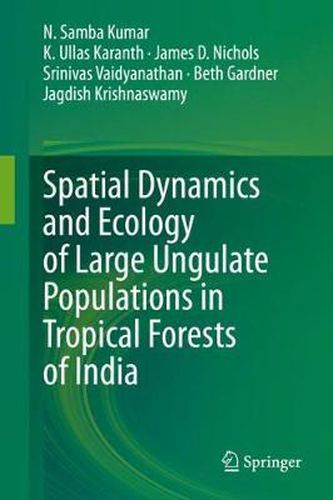Readings Newsletter
Become a Readings Member to make your shopping experience even easier.
Sign in or sign up for free!
You’re not far away from qualifying for FREE standard shipping within Australia
You’ve qualified for FREE standard shipping within Australia
The cart is loading…






This title is printed to order. This book may have been self-published. If so, we cannot guarantee the quality of the content. In the main most books will have gone through the editing process however some may not. We therefore suggest that you be aware of this before ordering this book. If in doubt check either the author or publisher’s details as we are unable to accept any returns unless they are faulty. Please contact us if you have any questions.
Large ungulates in tropical forests are among the most threatened taxa of mammals. Excessive hunting, degradation of and encroachments on their natural habitats by humans have contributed to drastic reductions in wild ungulate populations in recent decades. As such, reliable assessments of ungulate-habitat relationships and the spatial dynamics of their populations are urgently needed to provide a scientific basis for conservation efforts. However, such rigorous assessments are methodologically complex and logistically difficult, and consequently many commonly used ungulate population survey methods do not address key problems. As a result of such deficiencies, key parameters related to population distribution, abundance, habitat ecology and management of tropical forest ungulates remain poorly understood.
This book addresses this critical knowledge gap by examining how population abundance patterns in five threatened species of large ungulates vary across space in the tropical forests of the Nagarahole-Bandipur reserves in southwestern India. It also explains the development and application of an innovative methodology - spatially explicit line transect sampling - based on an advanced hierarchical modelling under the Bayesian inferential framework, which overcomes common methodological deficiencies in current ungulate surveys. The methods and results presented provide valuable reference material for researchers and professionals involved in studying and managing wild ungulate populations around the globe.
$9.00 standard shipping within Australia
FREE standard shipping within Australia for orders over $100.00
Express & International shipping calculated at checkout
Stock availability can be subject to change without notice. We recommend calling the shop or contacting our online team to check availability of low stock items. Please see our Shopping Online page for more details.
This title is printed to order. This book may have been self-published. If so, we cannot guarantee the quality of the content. In the main most books will have gone through the editing process however some may not. We therefore suggest that you be aware of this before ordering this book. If in doubt check either the author or publisher’s details as we are unable to accept any returns unless they are faulty. Please contact us if you have any questions.
Large ungulates in tropical forests are among the most threatened taxa of mammals. Excessive hunting, degradation of and encroachments on their natural habitats by humans have contributed to drastic reductions in wild ungulate populations in recent decades. As such, reliable assessments of ungulate-habitat relationships and the spatial dynamics of their populations are urgently needed to provide a scientific basis for conservation efforts. However, such rigorous assessments are methodologically complex and logistically difficult, and consequently many commonly used ungulate population survey methods do not address key problems. As a result of such deficiencies, key parameters related to population distribution, abundance, habitat ecology and management of tropical forest ungulates remain poorly understood.
This book addresses this critical knowledge gap by examining how population abundance patterns in five threatened species of large ungulates vary across space in the tropical forests of the Nagarahole-Bandipur reserves in southwestern India. It also explains the development and application of an innovative methodology - spatially explicit line transect sampling - based on an advanced hierarchical modelling under the Bayesian inferential framework, which overcomes common methodological deficiencies in current ungulate surveys. The methods and results presented provide valuable reference material for researchers and professionals involved in studying and managing wild ungulate populations around the globe.